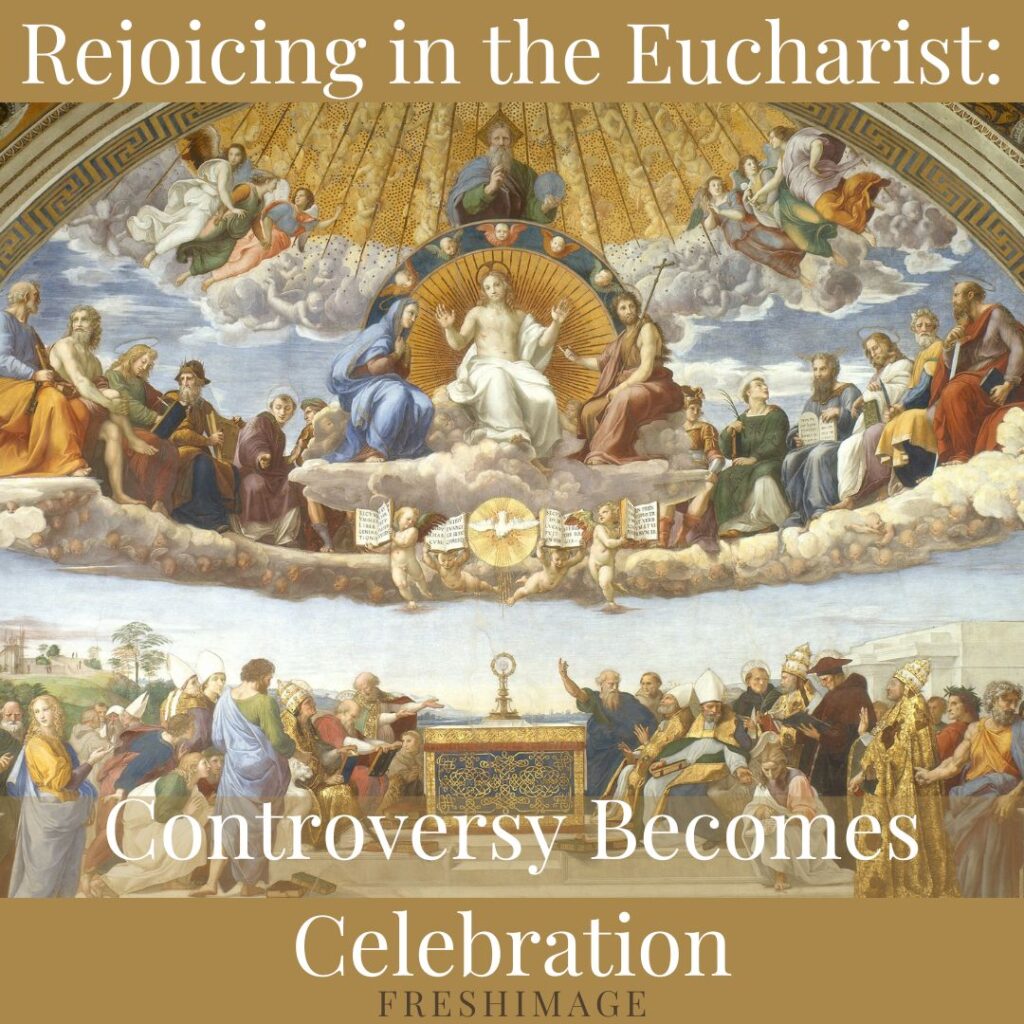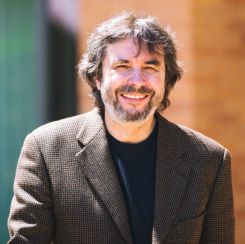
The Church’s teaching on Christ’s Real Presence is one of the Catholic faith’s central tenets and defines Catholic identity. It is also one of the most difficult to grasp. Even some of Jesus’ disciples were not initially ready to accept the words of their master regarding the Eucharist. St. John’s Gospel reports that quite many of them rejected His teaching and subsequently abandoned Him, saying, “This is a difficult statement; who can listen to it?” (John 6:60). Consequently, “many of His disciples withdrew and were not walking with Him anymore” (John 6:66). As the nascent Christian community grew, so too did the importance and centrality of the Eucharist.
All three Synoptic Gospels preserve the Institution Narrative from the Last Supper, while John’s Gospel includes the Bread of Life discourse cited above. The writings of St. Paul, too, emphasize the importance of the Eucharist for the Church. In First Corinthians, Paul writes,
The cup of blessing that we bless, is it not a sharing in the blood of Christ? The bread that we break, is it not a sharing in the body of Christ? Because there is one bread, we who are many are one body, for we all partake of the one bread (1 Corinthians 10:16-17).
In the following chapter, St. Paul provides the earliest record (ca. 56-57 AD) of the words of institution spoken by Jesus at the Last Supper.
For I received from the Lord what I also handed on to you, that the Lord Jesus on the night when he was betrayed took a loaf of bread, and when he had given thanks, he broke it and said, “This is my body that is for you. Do this in remembrance of me.” In the same way he took the cup also, after supper, saying, “This cup is the new covenant in my blood. Do this, as often as you drink it, in remembrance of me” (1 Corinthians 11:23-25).
The sacramental theology of the Early Church developed along the lines outlines in the New Testament. The significance of the Eucharist is seen in the effect it has on those who receive it. St. Augustine of Hippo epitomizes the perspective of the Early Church: “[Christ] took earth from earth, because flesh comes from the earth, and he received his flesh from the flesh of Mary. He walked here below in that flesh, and even gave us that same flesh to eat for our salvation” (en. Ps., 98.9).
Over time, difficulties arose concerning the Church’s understanding of the Eucharist in two directions, over-literalization and empty sign. The Church struggled to navigate the space between two ditches, as it were. On the one hand, there were those who overemphasized the literal side of the Eucharist, drifting towards an almost cannibalistic understanding thereof. This shows up in the work of 9th century theologian Paschasius Radbertus (792-865 AD), in response to the sacramental theology of another French theologian by the name of Ratramnus (800-868 AD). It is important to note that both theologians believed Christ to be really present in the Eucharist, but they disagreed about how Christ was really present. Ratramnus emphasized the figural or sacramental nature of the Eucharist. Radbertus thought Ratramnus had gone too far in this direction, and ended up over-emphasizing the literal nature of the Real Presence of Christ in the Eucharist, while undermining the sacramental nature of the Eucharist.
At the beginning of the 11th century, Berengar of Tours gave new life to the debate with his theology. Berengar was held in high esteem by some highly influential people such as Eusebius Bruno, Hubert de Vendôme (both future bishops of Angers, France), or Geoffrey II (Count of Anjou). Berengar’s theology seriously challenged the Real Presence of Christ in the Eucharist. He wrote that “the bread and wine of the Lord’s table are changed…not sensually but intellectually, not through an absorption but through an assumption.” Like Ratramnus before him, Berengar is veering towards emphasizing the significatory quality of the Eucharist to the detriment of the Real Presence of Christ in the Sacrament. Although Berengar ultimately recanted some of his most radical views, his theology which overemphasized the role of the individual recipient’s intellectual assent to Christ’s Presence in the Eucharist, paved the way for the future growth of Protestant theology which, especially in most radical works by Zwingli and Calvin, broke up the organic connection with the sacramental theology of the Catholic Church.
Berengar’s ambiguous stance led to a much broader discussion questioning the Real Presence, doubts about the doctrine became widespread in Christendom, resulting in an increasing lack of reverence for the Holy Sacrament. In 1215, the Fourth Lateran Council of the Church declared the doctrine of transubstantiation a part of the Church’s official teaching.
[Jesus Christ’s] Body and Blood are truly contained in the sacrament of the altar under the appearances of bread and wine, the bread being transubstantiated into the body by the divine power and the wine into the blood, to the effect that we receive from what is his what he has received from what is ours in order that the mystery of unity may be accomplished (Denzinger, 802).
Doubts surrounding the Eucharist remained, however. Peter of Prague was one of the skeptical clergymen, driven by hesitations about the nature of the Eucharist. When he made a pilgrimage to Rome at the bequest of his spiritual advisor, he stopped in the Italian town of Bolsena to celebrate a Mass. According to the tradition, when he uttered the words of Institution—“This is my body which will be given up for you”—the host started to drip blood. Right afterward, Peter, shocked and moved, went to nearby Orvieto, where Pope Urban IV resided. After an investigation, the pope declared that what happened in Bolsena was a miracle.
Sister Juliana of Liège greatly influenced James Pantaleon, who became Pope Urban IV. She confessed to him that she was tormented by a recurring dream in which she saw a moon with a black spot. Eventually, she had a vision of Jesus explaining to her that the moon represented the Christian liturgical year. The black stain stood for the missing feast: a feast in Honor of Jesus’ presence in the Eucharist.
After nearly forty years of Juliana’s ongoing efforts to obtain permission to organize a celebration honoring the presence of Jesus in the Eucharist. The bishop of Liège, Robert de Thorete, ordered in 1246 that the celebration of Corpus Christi should be held each year in the diocese. In reaction to the Eucharistic miracle in Bolsena, in 1264 Pope Urban IV, formally declared the feast of Corpus Christi the Solemnity of the Universal Church. He asked a modest young monk to write the liturgy of Corpus Christi Mass and the Vespers. The monk’s name was Thomas of Aquinas.
St. Thomas eventually provided a complete philosophical and theological response to Berengar’s school of thought. He defended the Church’s teaching from the Fourth Lateran Council on the Eucharist, and lead the Church to a deeper understanding of the issue. Thomas was able to safely navigate between the two ditches of over-literalism and empty sign with his sacramental theology, while simultaneously incorporating the central insight of the Early Church, the effect of receiving the Eucharist. He did so by distinguishing three things that should be considered in the Eucharist (See, Summa Theologica III, q. 73.6). First, the sacrament alone (sacramentum tantum), “and this is the bread and wine.” Second, both the sacrament and the reality (sacramentum et res), “Christ’s true body.” And third, the reality only (res tantum), “the effect of this sacrament,” union between Christ and His Church (see, Summa Theologica III, q. 79.1).
The Church’s ultimate response to the rejection of the Real Presence by many leaders of the Protestant Reformation came in the form of a decree and canons issued on October 11, 1551, by the Council of Trent (see Denzinger, 1651-1661).
Below is a fragment of one of St. Thomas’ Eucharistic hymns, Pange Lingua (vs. 1,3-5), that combines the expression of the Church’s orthodox teaching, poetic inspiration, and intensity of prayer.
SING, my tongue, the Savior’s glory,
of His flesh the mystery sing;
of the Blood, all price exceeding,
shed by our immortal King,
destined, for the world’s redemption,
from a noble womb to spring.
On the night of that Last Supper,
seated with His chosen band,
He the Pascal victim eating,
first fulfills the Law’s command;
then as Food to His Apostles
gives Himself with His own hand.
Word-made-Flesh, the bread of nature
by His word to Flesh He turns;
wine into His Blood He changes;-
what though sense no change discerns?
Only be the heart in earnest,
faith her lesson quickly learns.
Down in adoration falling,
Lo! the sacred Host we hail;
Lo! o’er ancient forms departing,
newer rites of grace prevail;
faith for all defects supplying,
where the feeble sense fail.

Andrzej Zahorski is Director of Music at St. Anselm Parish in St. Louis, MO. He holds a doctorate of musical arts from Stanford University.